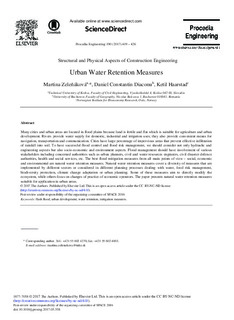| dc.contributor.author | Zelenakova, Martina | |
| dc.contributor.author | Diaconu, Daniel Constantin | |
| dc.contributor.author | Haarstad, Ketil | |
| dc.date.accessioned | 2018-03-20T12:33:46Z | |
| dc.date.available | 2018-03-20T12:33:46Z | |
| dc.date.created | 2018-01-26T11:09:06Z | |
| dc.date.issued | 2017-06-02 | |
| dc.identifier.citation | Procedia Engineering. 2017, 190 419-426. | nb_NO |
| dc.identifier.issn | 1877-7058 | |
| dc.identifier.uri | http://hdl.handle.net/11250/2491265 | |
| dc.description.abstract | Many cities and urban areas are located in flood plains because land is fertile and flat which is suitable for agriculture and urban development. Rivers provide water supply for domestic, industrial and irrigation uses; they also provide convenient means for navigation, transportation and communication. Cities have large percentage of impervious areas that prevent effective infiltration of rainfall into soil. To have successful flood control and flood risk management, we should consider not only hydraulic and engineering aspects but also socio-economic and environment aspects. Flood management should have involvement of various stakeholders including concerned authorities such as urban planners, civil and water resources engineers, civil disaster defence authorities, health and social services, etc. The best flood mitigation measures from all main points of view – social, economic and environmental are natural water retention measures. Natural water retention measures cover a diversity of measures that are implemented by different sectors or considered in different planning processes dealing with water, food risk management, biodiversity protection, climate change adaptation or urban planning. Some of these measures aim to directly modify the ecosystem, while others focus on changes of practice of economic operators. The paper presents natural water retention measures suitable for application in urban areas. | nb_NO |
| dc.language.iso | eng | nb_NO |
| dc.publisher | Elsevier | nb_NO |
| dc.rights | Attribution-NonCommercial-NoDerivatives 4.0 Internasjonal | * |
| dc.rights.uri | http://creativecommons.org/licenses/by-nc-nd/4.0/deed.no | * |
| dc.subject | flash flood | nb_NO |
| dc.subject | urban development | nb_NO |
| dc.subject | water retention | nb_NO |
| dc.subject | mitigation measures | nb_NO |
| dc.title | Urban Water Retention Measures | nb_NO |
| dc.type | Journal article | nb_NO |
| dc.type | Peer reviewed | nb_NO |
| dc.description.version | publishedVersion | nb_NO |
| dc.rights.holder | © 2017 The Author(s). Published by Elsevier Ltd. | nb_NO |
| dc.source.pagenumber | 419-426 | nb_NO |
| dc.source.volume | 190 | nb_NO |
| dc.source.journal | Procedia Engineering | nb_NO |
| dc.identifier.doi | 10.1016/j.proeng.2017.05.358 | |
| dc.identifier.cristin | 1552514 | |
| cristin.ispublished | true | |
| cristin.fulltext | original | |
| cristin.qualitycode | 1 | |

